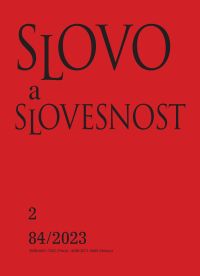Postavení ambipozic v češtině
The position of ambipositions in Czech
Author(s): Jakub Sláma, Barbora ŠtěpánkováSubject(s): Language studies, Language and Literature Studies, Theoretical Linguistics, Applied Linguistics, Syntax, Cognitive linguistics, Western Slavic Languages
Published by: AV ČR - Akademie věd České republiky - Ústav pro jazyk český
Keywords: adposition; ambiposition; cognitive linguistics; the complexity principle; random forests; syntactic variants; word-order
Summary/Abstract: The study proposes that some words in Czech, including ‘navzdory’ ‘despite’ and ‘počínaje’ ‘starting from,’ should be treated as ambipositions, i.e., adpositions that may either precede or follow their complement. This avoids the awkwardness of the traditional view on which the former, for instance, is a preposition when preceding a complement and a homonymous adverb when following one. Based on 3,234 corpus instances of ‘navzdory’ ‘despite,’ ‘nevyjímaje’ ‘including,’ ‘nemluvě o’ ‘not to mention,’ ‘počínaje’ ‘starting with,’ ‘konče’ ‘ending with,’ and ‘počínaje – konče’ ‘from – to,’ the study examines the factors determining whether ambipositions in Czech precede or follow their complements. Special attention is paid to the length and the syntactic complexity of the complement, but also to the text type and the position of the adpositional phrase in the clause. The study uses the random forests algorithm to gauge the relative importance of the variables for each of the ambipositions examined. The length of the complement is systematically the best predictor of the position of ambipositions: the longer the complement, the more likely the ambiposition is to precede it. This is argued to follow primarily from the limits of the human working memory.
Journal: Slovo a slovesnost
- Issue Year: 84/2023
- Issue No: 2
- Page Range: 91-121
- Page Count: 31
- Language: Czech

